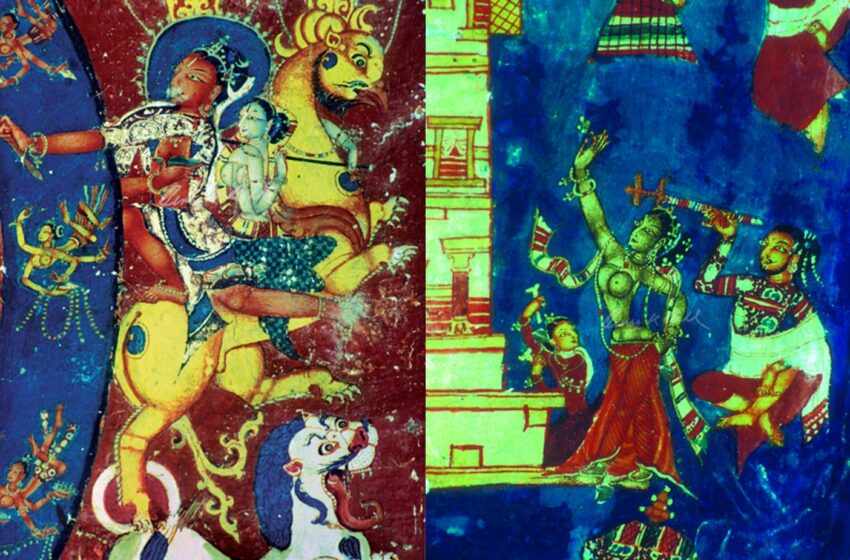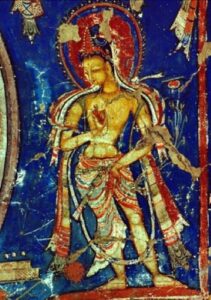Film on monasteries of Rinchen Zangpo to be screened at India Habitat Centre

Joyous representation of rider on mythical creature, Alchi, Ladakh (left) and Dancing Girl, Alchi (right). PIcs by Benoy K Behl
Team L&M
A film Monasteries of Rinchen Zangpo that provides the first comprehensive view of, covering the monasteries of Tibet, Ladakh, Lahaul-Spiti and Kinnaur, is being screened at India Habitat Centre (IHC), New Delhi on August 20 at 6pm. The film screening is a part of IHC series Glimpses of Culture.
Produced for Doordarshan by Art Historian, Film-maker & Photographer Benoy K Behl, the film takes us across the spectacle of the high-altitude lands of the trans-Himalayan region. Behl travelled to and covered all surviving monasteries and temples of this period for this film. “I often had to go by horseback or climb long distances uphill, in areas where no roads exist,” he reminisces.
Padmasambhava
The film carries many an interesting information like the story of Padmasambhava’s successful conversion of the people of the Trans-Himalayan lands which survives till today as the greatest legend of the entire region. The Guru swept across the mountains in the 8th century, performing the Cham (the monastic dance of the lamas), with which he purified the land and made it ready for Buddhism.
From 836 to 842 CE came a dark period in the history of Buddhism in Tibet when King Langdarma who was entirely opposed to the new religion persecuted Buddhists. Buddhist scriptures were burnt and temples were razed to the ground in an effort to wipe out the faith from the land.
King Yeshe Od

When King Yeshe ‘Od (947-1024) came to the throne of Guge, his kingdom consisted of the present Indian territories of Ladakh, Spiti and Kinnaur and Guge and Purang in Western Tibet. By then, Buddhism had declined in the Trans-Himalayas. What troubled the king most was that even the little practice of the religion which continued in small pockets was a decadent and corrupted form of the original faith. Around 975 AD, the king sent twenty-one young scholars to Kashmir, which was then one of the greatest centres of Buddhism, to learn about the pure faith and to bring back that knowledge and scriptures. These young men set out full of zeal and ardent desire, but the journey was long and difficult. Nineteen of them died in the travel to and from Kashmir.

Rinchen Zangpo
Of the two scholars who survived the journey to Kashmir and came back after 17 years, one was Rinchen Zangpo (958- 1055), who became famous for all time to come as Lohtsawa, ‘The Great Translator’. Rinchen Zangpo supervised the construction of many monasteries and temples, which became exquisite and brilliant jewels of the faith set in the midst of the vast spaces of the trans-Himalayan desert.
The Legendary 108 Monasteries
The Second Diffusion of Buddhism in the trans-Himalayas, which was begun by the ardors of King Yeshe ‘Od and Rinchen Zangpo, was a new dawn of the faith on the Roof of the World. The light of knowledge which they brought was to continue forever in these vast regions. The legendary 108 temples made at this time became the backbone of the revival of the true faith and remain the most deeply revered and, in fact, beloved monasteries of the people of these lands.
Monasteries
The 108 monasteries are believed to have been constructed in this period in the entire kingdom of Guge, in Western Tibet, Ladakh, Lahaul-Spiti and Kinnaur. There are many local legends, sometimes even magical stories describing how these beautiful monastic temples were constructed in a short space of time.
Art of Kashmiri Painters
King Yeshe Od and the subsequent kings who patronized the making of these monasteries, invited artists from Kashmir to build the monasteries and make the marvelous paintings and sculptures inside them. The painters and sculptors from Kashmir brought with them a highly sophisticated form of art, which was deeply rooted in the classic Sanskrit texts of India. The masters from Kashmir would have also trained local artists and there was a marvelous blending of the local idioms with the developed styles coming from Kashmir.
King Yeshe ‘Od and the great Translator Rinchen Zangpo wished not only to reestablish the Buddhist faith in the trans-Himalayas, but also to ensure that it was the true knowledge of the scriptures that would form the basis of this renaissance. In Buddhism, the cult of Vairocana, the Supreme and Resplendent form of the Buddha, was then prominent across India and especially in Kashmir. Rinchen Zangpo had studied scriptures related to mandalas of Vairocana during the time he spent in Kashmir. In this period, which came to be known as the Second Diffusion of Buddhism in the trans-Himalayas, it was primarily temples devoted to Vairocana which were set up. Rinchen Zangpo translated the Sarva Tathagata Tattva Samgraha (STTS), which was the principal doctrinal text of the Vairocana cult. The decorative and iconographic scheme inside the legendry 108 monasteries was based upon the Sarva Tathagata Tattva Samgraha and its commentaries. The cult of Vairocana also spread from India to China, Japan and Indonesia from the 8th century onwards.
The Kashmiri Roots of the Art of Tibet
Since times immemorial, Kashmir was known as Sharada Peeth, the Seat of the Goddess of Learning. In the 7th century, when Hseun Tsang visited India, Kashmir was a flourishing centre of Buddhism which rivaled the importance of Magadha, the area in which the Buddha had lived and preached. The Chinese pilgrim found many stupas and thousands of monks in the valley of Kashmir. Hseun Tsang stayed here and studied under a renowned Kashmiri teacher.
The art of Kashmir represents the continuation of the classic idiom of Indian art, as seen in the Gupta period sculpture and the paintings of Ajanta. In this valley, which was the meeting place of many cultures, we also see the artistic influences of Bactro-Gandhara, Persia and Central Asia.
In the 8th century, King Lalitaditya’s capital Parihaspura was one of the great centres of Buddhism in the world. Magnificent stupas were built here by the King and by Chankuna, his Tokharian minister. A mural of the 12th-13th century in a temple of the Alchi monastery displays what may have been the architectural style of the stupas of Kashmir at that time. The monuments which were built by King Lalitaditya, the 9th century temples of King Avantivarman at Avantipura, the almost intact temple of the 8th / 9th century which remains at Pandarethan, near Srinagar and others show the wealth and diversity of the cultural roots of Kashmiri architecture. The trefoiled arches seen here, probably derived from Gandhara, and the triangular gables which are reminiscent of Byzantine and Syrian buildings, were to be replicated in times to come in the monasteries which were made by Kashmiri architects and sculptors in the Trans- Himalayas.




